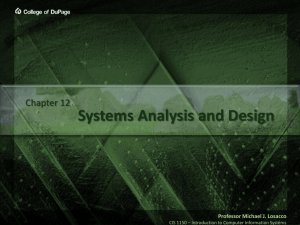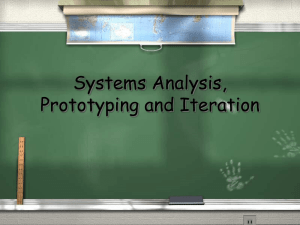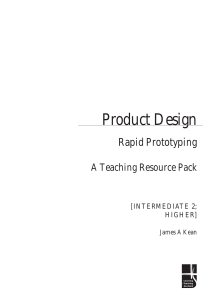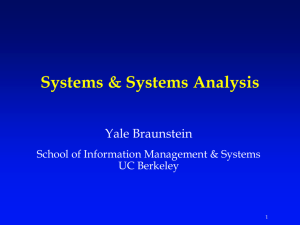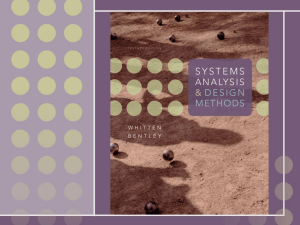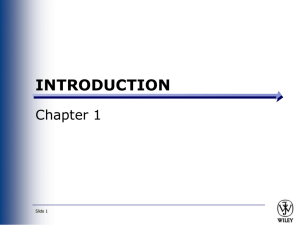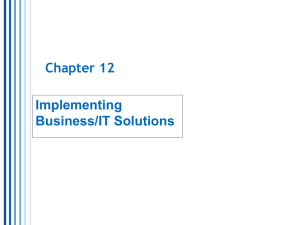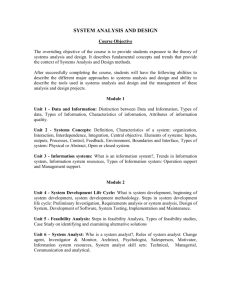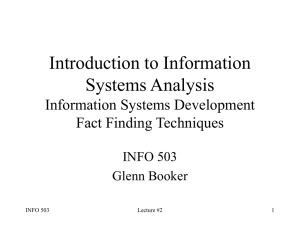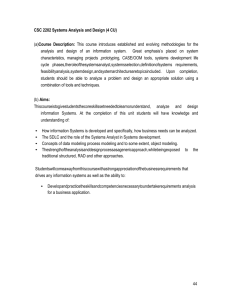final_review_ism58
advertisement
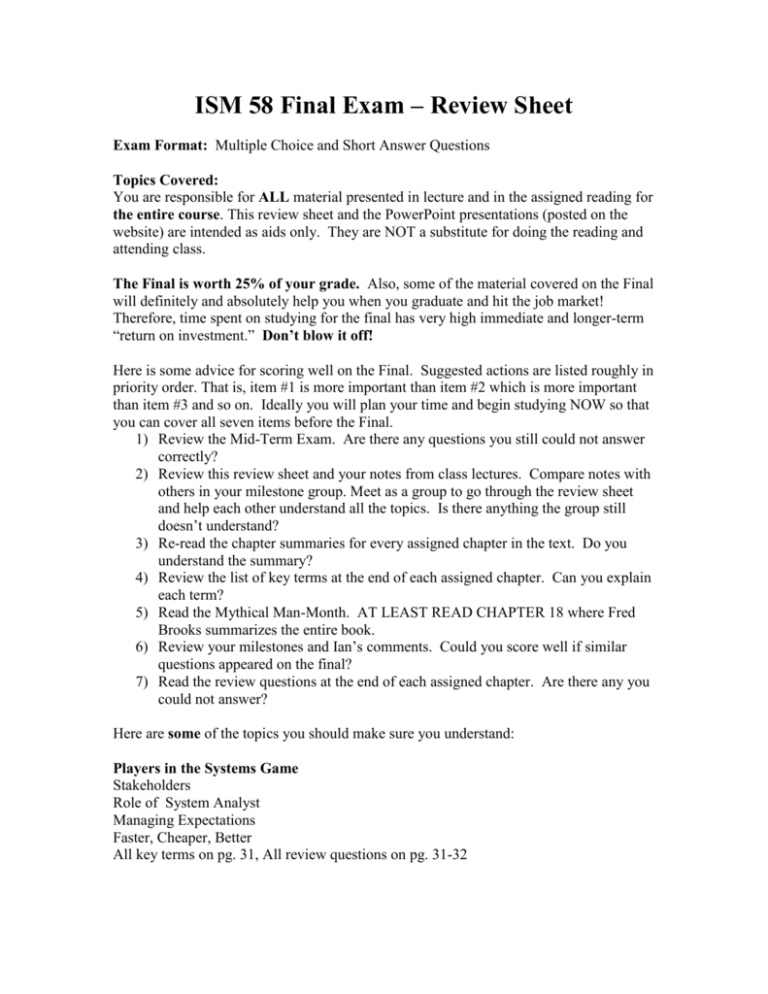
ISM 58 Final Exam – Review Sheet Exam Format: Multiple Choice and Short Answer Questions Topics Covered: You are responsible for ALL material presented in lecture and in the assigned reading for the entire course. This review sheet and the PowerPoint presentations (posted on the website) are intended as aids only. They are NOT a substitute for doing the reading and attending class. The Final is worth 25% of your grade. Also, some of the material covered on the Final will definitely and absolutely help you when you graduate and hit the job market! Therefore, time spent on studying for the final has very high immediate and longer-term “return on investment.” Don’t blow it off! Here is some advice for scoring well on the Final. Suggested actions are listed roughly in priority order. That is, item #1 is more important than item #2 which is more important than item #3 and so on. Ideally you will plan your time and begin studying NOW so that you can cover all seven items before the Final. 1) Review the Mid-Term Exam. Are there any questions you still could not answer correctly? 2) Review this review sheet and your notes from class lectures. Compare notes with others in your milestone group. Meet as a group to go through the review sheet and help each other understand all the topics. Is there anything the group still doesn’t understand? 3) Re-read the chapter summaries for every assigned chapter in the text. Do you understand the summary? 4) Review the list of key terms at the end of each assigned chapter. Can you explain each term? 5) Read the Mythical Man-Month. AT LEAST READ CHAPTER 18 where Fred Brooks summarizes the entire book. 6) Review your milestones and Ian’s comments. Could you score well if similar questions appeared on the final? 7) Read the review questions at the end of each assigned chapter. Are there any you could not answer? Here are some of the topics you should make sure you understand: Players in the Systems Game Stakeholders Role of System Analyst Managing Expectations Faster, Cheaper, Better All key terms on pg. 31, All review questions on pg. 31-32 Information System Building Blocks Types of information systems Zachman Framework Six perspectives, three foci of the Zachman model All key terms on pg. 68, All review questions on pg. 68 Information Systems Development CMM model Model Driven Development (MDD) RAD, COTS, FAST, ERP, BPR System lifecycle System development phases Cross-life cycle activities CASE ADE All key terms on pg. 113, All review questions on pg 113 Project Management Scope Scope creep Serial v.s. parallel development phases Resource leveling Right-to-left schedule Gantt charts, Pert charts Good v. Poor management Change management Deliverables, Schedule, Budget Systems Analysis Model-Driven Analysis Accelerated systems analysis Prototyping Phases of systems analysis All key terms on pg. 206, All review questions on pg 207 Requirements Discovery Requirements elicitation methods All key terms on pg. 251, All review questions on pg 251 System Concepts, Logical Data Modeling, Constructing Data Models Logical v.s. physical models ERD Entities Attributes Keys (primary, foreign) Cardinality Associative entities Identifying and non-identifying relationships Non-specific relationships, resolving them Generalization Stages in constructing a logical data model Normalization All key terms on pg. 299, All review questions on pg. 300 System Concepts, Logical Process Models, Constructing Process Models Why process models? Why data models? DFD System decomposition Data flows, Processes, Data stores Context flow diagrams Functional decomposition diagram Event list Structured English Decision table Use cases CRUD All key terms on pg 356, All review questions on pg. 357 Feasibility Analysis Four tests for Feasibility Cost-Benefit Analysis Techniques Candidate Systems Matrix Feasibility Analysis Matrix System Proposals Key terms pg. 388; Review questions 389 System Design Methods RAD FAST Build vs. Buy Key terms pg. 416; Review questions pg. 416 Application Architecture & Modeling Physical DFDs Five Architectural Styles (from Lecture) Data architecture Interface architecture Process architecture Client – Server architectures When to use what type of architecture Key terms pg. 462; Review questions pg. 462. Database Design Conventional files vs. the database Database concepts: fields, records, tables, and databases Normalization Database schemas Data integrity / referential integrity Key terms pg. 496; Review questions pg. 497 Output Design & Prototyping Types of outputs When to use what type of output Output design guidelines Your ability to argue for a given output design given a scenario Key terms pg. 529; Review questions pg. 529 Input Design & Prototyping Concepts / guidelines GUI design issues Automated tools for input design / prototyping Key terms pg. 563; Review questions 563-564 User Interface Design Three golden rules of usability (from lecture) UI Design concepts / guidelines (text) Human Factors UI for the web; GUI issues How to design/prototype a UI How would you improve the Sliders system you used for homework and in group lab? Key terms pg. 598; Review questions 598-599 Mythical Man Month Material covered in lecture (see slides on web) Chapter 18 (summary) Other material in the book Craig’s Key Concepts That will Help You in Your Career and Your Life Managing expectations / Building & maintaining credibility Right to left schedule Risk / Reward Buy-in / User involvement Cost of Quality Prioritization ROI Capsule course in human relations (from Coca Cola’s ex-chairman) Elevator pitch / expandable presentations Good vs. poor management techniques
